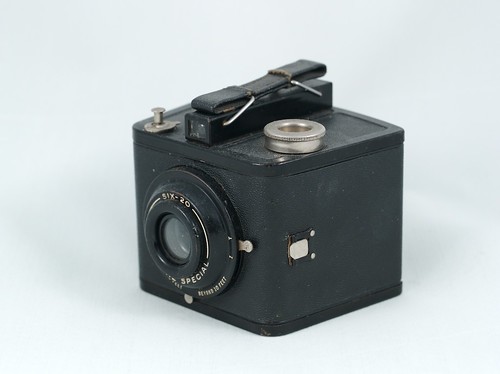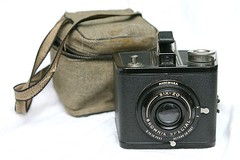Difference between revisions of "Kodak Six-20 Brownie Special"
m |
m (changed one from cp to cw pool, one still remain) |
||
| Line 1: | Line 1: | ||
{{Flickr_image | {{Flickr_image | ||
| − | |image_source= http://www.flickr.com/photos/source/318819549 | + | |image_source= http://www.flickr.com/photos/source/318819549/ |
|image= http://farm1.static.flickr.com/137/318819549_09986e4ae6.jpg | |image= http://farm1.static.flickr.com/137/318819549_09986e4ae6.jpg | ||
|image_align= right | |image_align= right | ||
|image_text= Six-20 Brownie Special | |image_text= Six-20 Brownie Special | ||
| + | |image_by Diego Cantalapiedra | ||
| + | |image_rights= non-commercial | ||
}} | }} | ||
The '''Kodak Six-20 Brownie Special''' was a sheet metal [[box camera]] made for [[120 film#620_film| 620 roll film]] by [[Kodak]] in the USA. Production ran from Sept 1938-Oct 1942 to a design by [[Walter Dorwin Teague]]. Initial price in the US was $4.00<ref>[http://www.kodak.com/global/en/consumer/products/techInfo/aa13/aa13.pdf Kodak.com's History of Kodak Cameras]</ref>. The Brownie Special was replaced by the '''[[Kodak Six-20 Flash Brownie]]''' - which was virtually the same camera with the addition of [[flash sync]]. | The '''Kodak Six-20 Brownie Special''' was a sheet metal [[box camera]] made for [[120 film#620_film| 620 roll film]] by [[Kodak]] in the USA. Production ran from Sept 1938-Oct 1942 to a design by [[Walter Dorwin Teague]]. Initial price in the US was $4.00<ref>[http://www.kodak.com/global/en/consumer/products/techInfo/aa13/aa13.pdf Kodak.com's History of Kodak Cameras]</ref>. The Brownie Special was replaced by the '''[[Kodak Six-20 Flash Brownie]]''' - which was virtually the same camera with the addition of [[flash sync]]. | ||
| Line 10: | Line 12: | ||
Images were 2¼x3¼ inches (6x9cm). | Images were 2¼x3¼ inches (6x9cm). | ||
| − | |||
| − | |||
| − | |||
The [[Kodak Brownie Special six-16|Six-16 Brownie Special]] was a larger version, for [[116 film|616 film]]. | The [[Kodak Brownie Special six-16|Six-16 Brownie Special]] was a larger version, for [[116 film|616 film]]. | ||
| − | |||
| − | |||
| − | |||
| − | |||
| − | |||
{{Flickr_image | {{Flickr_image | ||
|image_source= http://www.flickr.com/photos/radioripster/1003536256/in/pool-camerapedia | |image_source= http://www.flickr.com/photos/radioripster/1003536256/in/pool-camerapedia | ||
| Line 24: | Line 18: | ||
|image_align= left | |image_align= left | ||
|image_text= Six-20 Brownie Special with bag<br><small>"Made in USA" above lens</small> | |image_text= Six-20 Brownie Special with bag<br><small>"Made in USA" above lens</small> | ||
| + | |image_by=Marc Henderson | ||
| + | |image_rights= | ||
}} | }} | ||
| + | The lens was a fixed-aperture meniscus, with two focus settings, 5-10ft & 10ft-infinity. The shutter was single-speed (+T) rotary. | ||
| + | {{br}} | ||
| + | |||
| + | === references === | ||
| + | <references /> | ||
| + | === Links === | ||
| + | |||
* [http://www.geh.org/fm/Brownie/htmlsrc/mE13000052_ful.html Six-20 Brownie Special] on [http://www.geh.org/ George Eastman House site] | * [http://www.geh.org/fm/Brownie/htmlsrc/mE13000052_ful.html Six-20 Brownie Special] on [http://www.geh.org/ George Eastman House site] | ||
In French: | In French: | ||
Revision as of 01:05, 2 June 2011

|
| Six-20 Brownie Special (Image rights) |
The Kodak Six-20 Brownie Special was a sheet metal box camera made for 620 roll film by Kodak in the USA. Production ran from Sept 1938-Oct 1942 to a design by Walter Dorwin Teague. Initial price in the US was $4.00[1]. The Brownie Special was replaced by the Kodak Six-20 Flash Brownie - which was virtually the same camera with the addition of flash sync.
The trapezoidal body had a curved back, an optical viewfinder on top, and a fold-out foot on one side for standing the camera in portrait format. The shutter release had a locking collar set around it.
Images were 2¼x3¼ inches (6x9cm). The Six-16 Brownie Special was a larger version, for 616 film.

|
| Six-20 Brownie Special with bag "Made in USA" above lens image by Marc Henderson |
The lens was a fixed-aperture meniscus, with two focus settings, 5-10ft & 10ft-infinity. The shutter was single-speed (+T) rotary.
references
Links
In French:
- Six-16 brownie Special on www.collection-appareils.fr by Sylvain Halgand